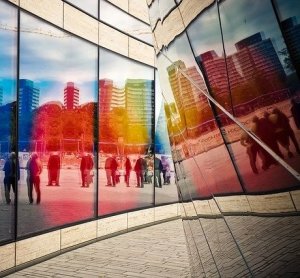Submitted by Anonymous on

Image: Michael Gaida / Pixabay
By James H. Lee
Urbanization seemed like an obvious trend, and then COVID-19 changed the world.
Can cities flourish after a pandemic? They often do. New York, Paris, and London experienced rapid growth after the Spanish Flu of 1918. People will always search for the connections that cities provide.
Urbanization has been trending for over 300 years. However, the COVID-19 pandemic and economic aftershocks could have ripple effects of delaying the growth of larger cities by up to a decade. Smaller towns, cities, and suburbs may benefit in the short term. The shift toward communal living and the shared economy might also be on temporary hold.
Futurists use scenarios as a tool for discussing uncertain futures. Four scenario archetypes are Growth, Discipline, Transformation, and Collapse. Scenarios can help identify which future is being experienced and enable people to think about the best ways of investing for a quickly changing world. Consider these post-pandemic scenarios:
The Urban Environment (Growth). After the pandemic, people quickly return to the cities, and it is mostly business as usual. Outdoor dining is increasingly popular. Cities appear healthier and better landscaped. New shops and boutiques take the place of old ones, and private life becomes public once again. There are still some social precautions (less hugging and handshaking), but overall, people are enjoying themselves. Live theater and events continue to bring people in from the suburbs.
The shared economy moves forward, with coworking spaces and Uber/Lyft taxis regaining their earlier popularity. There is a work–life balance between home and downtown.
New trends, fashions, and forms of entertainment are constantly being invented, making the city an interesting place to live. People are happy to forget about quarantine and want to catch up on travel and life.
The Restrained City (Discipline). City life continues, but it lacks the vibrancy of the past. Social distancing practices stay in effect long after the initial threat is over. Many new regulations are in place, making it harder to do business.
There has been some migration out of the largest cities (Chicago, New York, San Francisco), and there are still lingering fears of contagion. Retail has made a permanent shift to online, and it takes years for some storefronts to reopen. Some of these have been repurposed as after-school learning centers, meditation spaces, private clubs, and small offices.
Health-care screening at airports and for public transportation poses some difficulty for travel, but housing is now affordable.
More-affluent communities have started programs of public surveillance for both crime and health-care risks.
Some cities are experiencing financial pressure and spending cuts due to lost tax revenues. For the young and adventuresome, though, cities are still the place to meet people and find opportunity.
The Vibrant City (Transformation). The health-care industry has responded rapidly, and not only is there a vaccine for COVID-19, but there are also entirely new classes of synthetic antibodies that could be used for any future viral outbreak, making pandemics a thing of the past.
Cities are a remarkably clean, fun, and efficient place to live. People work as much as they want to. There are fewer jobs, but the productivity of automation has given everybody more time for learning, the arts, and entertainment. People seem genuinely kinder and more appreciative of each other.
There is plenty of room for creativity—public events and street festivals happen on a regular basis, and there is a sense of neighborhood pride and community.
The War Zone (Collapse). The pandemic has given way to high unemployment and social tension. There are now parts of cities that even the police are hesitant to enter. The tax base has fled to the suburbs and smaller towns, and those who remain stay indoors to live mostly in games and simulations. Cities provide basic services, but little else. Landlords are happy to rent their empty apartment units at any price. Banks have foreclosed on many buildings, and businesses are staying out of downtown areas.
Which of these scenarios should we expect? I am a cautious optimist. We may move from one scenario to the next, starting with the Discipline scenario for the next 2-3 years, followed by a period of Growth for the remainder of the decade. What actually happens will be determined by a combination of personal resilience, collective trust, and our ability to move forward.
About the Author
Jim Lee, founder of StratFi, is a certified financial planner and an active member of the Association of Professional Futurists. This article was excerpted from his forthcoming book, Foresight Investing: A Complete Guide to Finding Your Next Great Trade.
Image by Michael Gaida from Pixabay
